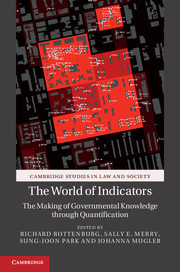Book contents
- Frontmatter
- Contents
- List of figures
- List of tables
- List of abbreviations
- List of contributors
- 1 A world of indicators: The making of governmental knowledge through quantification
- 2 The flight of the indicator
- 3 Narrating numbers
- 4 By their own account: (Quantitative) Accountability, Numerical Reflexivity and the National Prosecuting Authority in South Africa
- 5 Failure by the numbers? Settlement statistics as indicators of state performance in South African land restitution
- 6 Doing the transparent state: Open government data as performance indicators
- 7 Charting the road to eradication: Health facility data and malaria indicator generation in rural Tanzania
- 8 ‘Nobody is going to die’: An ethnography of hope, indicators and improvizations in HIV treatment programmes in Uganda
- 9 Financial indicators and the global financial crash
- 10 New global visions of microfinance: The construction of markets from indicators
- 11 Spirits of neoliberalism: ‘Competitiveness’ and ‘wellbeing’ indicators as rival orders of worth
- 12 Climate change vulnerability indicators: from noise to signal
- 13 Retroaction: how indicators feed back onto quantified actors
- Index
- Cambridge Studies in Law and Society
- References
12 - Climate change vulnerability indicators: from noise to signal
Published online by Cambridge University Press: 05 October 2015
- Frontmatter
- Contents
- List of figures
- List of tables
- List of abbreviations
- List of contributors
- 1 A world of indicators: The making of governmental knowledge through quantification
- 2 The flight of the indicator
- 3 Narrating numbers
- 4 By their own account: (Quantitative) Accountability, Numerical Reflexivity and the National Prosecuting Authority in South Africa
- 5 Failure by the numbers? Settlement statistics as indicators of state performance in South African land restitution
- 6 Doing the transparent state: Open government data as performance indicators
- 7 Charting the road to eradication: Health facility data and malaria indicator generation in rural Tanzania
- 8 ‘Nobody is going to die’: An ethnography of hope, indicators and improvizations in HIV treatment programmes in Uganda
- 9 Financial indicators and the global financial crash
- 10 New global visions of microfinance: The construction of markets from indicators
- 11 Spirits of neoliberalism: ‘Competitiveness’ and ‘wellbeing’ indicators as rival orders of worth
- 12 Climate change vulnerability indicators: from noise to signal
- 13 Retroaction: how indicators feed back onto quantified actors
- Index
- Cambridge Studies in Law and Society
- References
Summary
Introduction
Using several examples, this chapter explores the application, advantages, limitations and academic debate with respect to climate change vulnerability indicators (CCVIs) as complexity-reducing representations of societal vulnerability to climate change. In recent years, the need has increased for understanding the factors which determine the vulnerability of societies around the world to climate change. Decision- and policy-makers are in need of useful and usable information on this matter to reduce climate change vulnerability, and require it in a way that permits the development of appropriate policies in a given context. CCVIs appear to be an example of how such information is provided: they are a means of quantifying societal vulnerabilities to climate change into a single number, and of communicating to policy-making how vulnerable particular entities are to specific aspects of climate change.
The following example illustrates the need and provision of such indicator-driven information on climate change vulnerability. In November 2008, the sub-committee for the Pilot Program for Climate Resilience (PPCR) of the Climate Investment Funds (CIF), initiated by the World Bank, appointed an expert group to produce a list of ten countries or regions that are the most vulnerable to anthropogenic climate change. These countries were to benefit from the funding of the PPCR programme for actions toward improved climate change resilience. By September 2010, the PPCR fund had grown to roughly US$1 billion, receiving aid from several different donor countries (Climate Investment Funds 2010). In the face of this substantial sum, transparency and replicability in selecting the receiving countries were of key importance. The expert group therefore decided on an approach based on the use of vulnerability indicators (Brooks et al. 2009).
The identification of the most vulnerable countries with regard to climate change is a task of large complexity, one that begins with the very notion of vulnerability. The aspects of vulnerability investigated often included health, food security, access to water, or the capacity to adapt and develop different combinations of these. If it is difficult to quantify the current status of any of these aspects (let alone if available data is scarce, which is often the case), it is even more difficult to derive their dependence on climate and to estimate how they evolve under a future, changing climate.
- Type
- Chapter
- Information
- The World of IndicatorsThe Making of Governmental Knowledge through Quantification, pp. 307 - 328Publisher: Cambridge University PressPrint publication year: 2015
References
- 1
- Cited by



